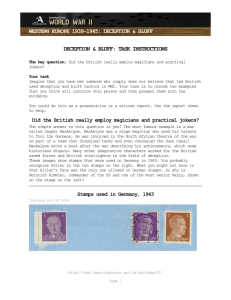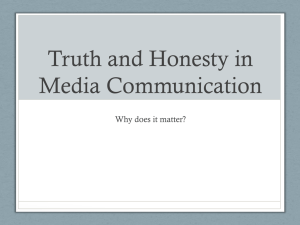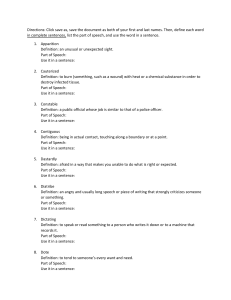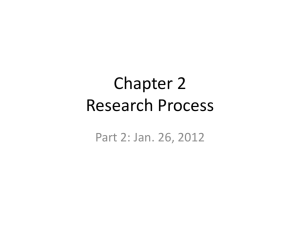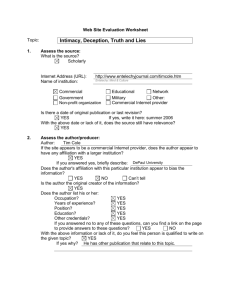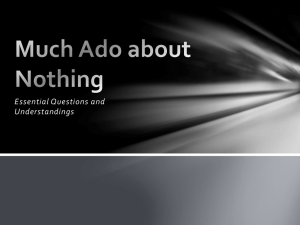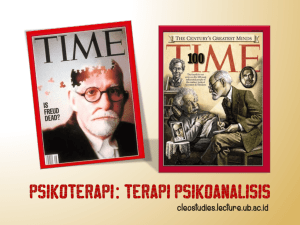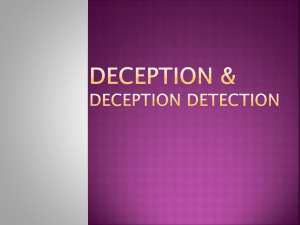WESTERN EUROPE 1939-1945: DECEPTION & BLUFF DECEPTION & BLUFF: TASK INSTRUCTIONS
advertisement
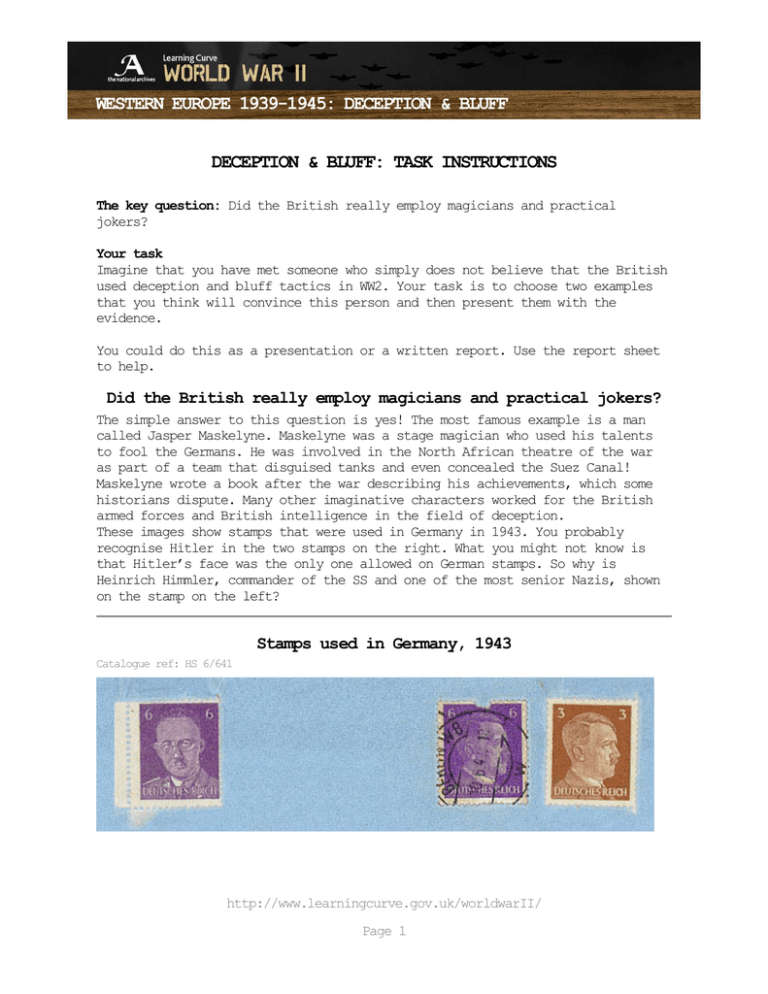
WESTERN EUROPE 1939-1945: DECEPTION & BLUFF DECEPTION & BLUFF: TASK INSTRUCTIONS The key question: Did the British really employ magicians and practical jokers? Your task Imagine that you have met someone who simply does not believe that the British used deception and bluff tactics in WW2. Your task is to choose two examples that you think will convince this person and then present them with the evidence. You could do this as a presentation or a written report. Use the report sheet to help. Did the British really employ magicians and practical jokers? The simple answer to this question is yes! The most famous example is a man called Jasper Maskelyne. Maskelyne was a stage magician who used his talents to fool the Germans. He was involved in the North African theatre of the war as part of a team that disguised tanks and even concealed the Suez Canal! Maskelyne wrote a book after the war describing his achievements, which some historians dispute. Many other imaginative characters worked for the British armed forces and British intelligence in the field of deception. These images show stamps that were used in Germany in 1943. You probably recognise Hitler in the two stamps on the right. What you might not know is that Hitler’s face was the only one allowed on German stamps. So why is Heinrich Himmler, commander of the SS and one of the most senior Nazis, shown on the stamp on the left? Stamps used in Germany, 1943 Catalogue ref: HS 6/641 http://www.learningcurve.gov.uk/worldwarII/ Page 1 WESTERN EUROPE 1939-1945: DECEPTION & BLUFF What is this source? This is a collection of stamps used in Germany in the later stages of the war. The stamp on the left is a fake stamp that was produced in Britain. The actual image shown here is taken from an envelope that was posted in Germany and arrived in Switzerland late in 1943. What’s the background to this source? By late 1943 the tide of war was beginning to turn against Germany. There was some evidence that German morale was poor. The British intelligence agencies were keen to take any opportunity that they could to try and stir up trouble in Germany. They came up with this idea of creating a stamp bearing the head of Heinrich Himmler. They hoped this would make Germans think that Himmler was trying to overthrow Hitler. Heinrich Himmler was one of the most powerful Nazis. He controlled the SS. This huge organisation was almost a state inside the German state. It had its own armed forces and factories. It controlled the police and the Gestapo (secret police) and the concentration camps for Jews and other enemies of the Nazis. The SS certainly could have arranged to have stamps printed if Himmler had been plotting to overthrow Hitler. The British were hoping to cause doubt and suspicion between the leading Nazis. It’s worth knowing that... Despite all this power, Himmler was not one of Hitler’s closest companions. In fact, in 1945, he tried to start negotiations with the British and American leaders to get them to join Germany against the USSR. Hitler had him arrested. Hitler actually made a lot of money out the use of his portrait on stamps. He charged the German post office a royalty for using his image, even though they had to! As a result another head appearing on stamps would have caused a lot of talk. How does this source help us to understand the importance of deception tactics during the war? 1. What kind of images do you see on stamps in Britain today, and in other countries? 2. Imagine the Queen’s head was replaced on stamps by another image (e.g. the Prime Minister). Do you think this would cause controversy in Britain today? http://www.learningcurve.gov.uk/worldwarII/ Page 2 WESTERN EUROPE 1939-1945: DECEPTION & BLUFF 3. Do you think the Himmler stamp would cause more controversy in Germany in 1943-44? 4. Do you think this source can help you to convince your friend that the British used deception tactics in WW2? Extracts from a letter from a British intelligence officer, June 1945 Catalogue ref: HS 6/641 Extract a http://www.learningcurve.gov.uk/worldwarII/ Page 3 WESTERN EUROPE 1939-1945: DECEPTION & BLUFF Extract b What is this source? A British intelligence officer wrote this letter to Lt Colonel Rawlinson of the British Army. The writer wanted the Colonel to ask any prisoners he was holding if they remembered the issuing of the Himmler stamps (see the opening source to this investigation) and what impact it had. What’s the background to this source? By late 1943 the tide of war was beginning to turn against Germany. There was some evidence that German morale was poor. The British intelligence agencies were keen to take any opportunity that they could to try and stir up trouble in Germany. They came up with this idea of creating a stamp bearing the head of Heinrich Himmler. They hoped this would make Germans think that Himmler was trying to overthrow Hitler. Heinrich Himmler was one of the most powerful Nazis. He controlled the SS. This huge organisation was almost a state inside the German state. It had its own armed forces and factories. It controlled the police and the Gestapo (secret police) and the concentration camps for Jews and other enemies of the Nazis. The SS certainly could have arranged to have stamps printed if Himmler had been plotting to overthrow Hitler. The British were hoping to cause doubt and suspicion between the leading Nazis. http://www.learningcurve.gov.uk/worldwarII/ Page 4 WESTERN EUROPE 1939-1945: DECEPTION & BLUFF It’s worth knowing that... Himmler was captured in 1945 but he took poison and killed himself before he could be interrogated. The fact that the letter writer wanted this information suggests that he did not know what kind of impact the fake stamps had on the Nazi leadership. How does this source help us to understand the importance of deception tactics during the war? 1. Why did the letter writer believe his project had been a great success? 2. What impact do you think this stamp and the articles about it might have had? 3. Can we tell from this source whether the stamps affected the Nazi commanders? 4. Do you think this source can help you to convince your friend that the British used deception tactics in WW2? You could do this as a presentation or a written report. Use the report sheet to help. http://www.learningcurve.gov.uk/worldwarII/ Page 5 WESTERN EUROPE 1939-1945: DECEPTION & BLUFF Extracts from memorandum by the First Lord of the Admiralty to the War cabinet, October 1941 Catalogue ref: CAB 86/1 What is this source? This is a memorandum or note from the First Lord of the Admiralty to the War cabinet commenting on the use of coal dust to camouflage the coastline. http://www.learningcurve.gov.uk/worldwarII/ Page 6 WESTERN EUROPE 1939-1945: DECEPTION & BLUFF Experiments were carried out to use coal dust to disguise the outline of the coast and other inland waterways and rivers, thus making it difficult for German bombers to attack ports, docks and estuaries. The film of coal dust would cut out any reflection from the water and make it less visible. What’s the background to this source? After the Battle of Britain in October 1940, Hitler had renewed plans for Operation Sealion (the invasion of Britain) in the spring of 1941. However, with the Nazi attack on the Soviet Union in June 1941, it became unlikely that Hitler would invade until this conflict on the Eastern Front was resolved. The Battle of the Atlantic however, continued at this time. The Royal Navy, along with other Allied navies had the task of defending from German surface and U boat attack, merchant ships carrying essential food and supplies. It’s worth knowing that... These plans to camouflage the coastline were rejected in the end. There were too many problems. It was a wasteful use of vital coal during wartime and caused rivers to silt up. Tides would wash away the coal dust film and break up the cover. This experiment shows that the government was interested in the use of camouflage and was prepared to consider all sorts of ideas! How does this source help us to understand why D-Day was successful? 1. 2. 3. 4. What was the main idea behind this experiment? Why was it not really practical? Why might people today object to such plans? Do you think this source can help you to convince your friend that the British used deception tactics in WW2? http://www.learningcurve.gov.uk/worldwarII/ Page 7 WESTERN EUROPE 1939-1945: DECEPTION & BLUFF Deception carried out by the navy, 1942-44 Catalogue ref: ADM 212/129 What is this source? This photograph shows a Royal Navy ship using experimental camouflage. The photograph comes from the records of the Admiralty’s research laboratory. The idea was to camouflage ships against land backgrounds. The diagram shows how many umbrellas were needed to camouflage a ship. The purpose was to provide a quick solution. The structural camouflage (the umbrellas) would be used as well as painted camouflage. The umbrellas also broke up the outline of the ship. This made it difficult for an aircraft or a submarine to work out what kind of ship it was. The umbrellas would help the ships to avoid attack or even allow them to lie unobserved in order to ambush enemy shipping expected in the area. It was thought that such circumstances might occur in the Far Eastern theatre of war. The Admiralty was the department of government that looked after the navy. What’s the background to this source? Throughout British history the navy has always been the most important of the armed forces, because Britain is an island and is also a trading nation which needs to protect its shipping. The navy played a critical role in WW2. It helped to deter Hitler from invading Britain in 1940. It also helped to http://www.learningcurve.gov.uk/worldwarII/ Page 8 WESTERN EUROPE 1939-1945: DECEPTION & BLUFF protect Britain’s vital supply convoys as they crossed the Atlantic from North America. The biggest threats to naval ships and merchant ships came from aircraft and submarines firing torpedoes. The Royal Navy was always interested in new ideas. In December 1941 the navy received a devastating blow as they lost two battleships to torpedoes fired by Japanese aircraft. The other key danger to naval ships was torpedo attack by submarine. Torpedoes were expensive and valuable, so enemies would usually only fire them if they were sure about their target. Anything that would give doubt to an attacker was potentially useful. It’s worth knowing that... As well as illusionists, the armed forces also used artists. Surrealist artists like Paul Nash tried different ideas for camouflaging ships and other weapons. They were designed to fool aircraft from a distance, and would not have fooled anyone close up. Scientists also played their role in military research. One scientist at the Admiralty laboratory was Francis Crick. He went on to become one of the discoverers of DNA. How does this source help us to understand the importance of deception tactics during the war? 1. What are the 2. Try blocking know what it 3. Do you think British used advantages of using these umbrellas as a camouflage method? out the sea and showing the picture to someone who does not is. How effective is the camouflage when you do this? this source can help you to convince your friend that the deception tactics in WW2? http://www.learningcurve.gov.uk/worldwarII/ Page 9 WESTERN EUROPE 1939-1945: DECEPTION & BLUFF Diagram to show the umbrellas in position Catalogue ref: ADM 212/129 Deception carried out by the British army, May 1941 Catalogue ref: WO 201/2841 http://www.learningcurve.gov.uk/worldwarII/ Page 10 WESTERN EUROPE 1939-1945: DECEPTION & BLUFF What is this source? This photograph shows a tank fitted with coverings to make it look like a truck. The coverings were made of plywood and painted canvas. What’s the background to this source? During the early stages of the war in 1939-40, the Germans used aircraft very effectively to attack enemy ground forces. Aircraft were also very effective at spotting enemy targets and giving their positions to their artillery. Disguises like this were designed to confuse and mislead enemy pilots. Deceptions like this one were tried out quite early in the war. For example, ‘concrete’ forts were actually made of plywood and canvas. They were used on a large scale in the campaigns against German and Italian troops in North Africa. As well as tanks made to look like trucks, the army made trucks to look like tanks! This was useful in convincing the Germans that the British were massing tanks in one area for an attack when they were actually planning to attack somewhere else. Deception was used on a very large scale just before the D-Day landings. Here the allies used radar, inflatable tanks, trucks and even aircraft to deceive enemy aircraft. It’s worth knowing that... British commanders were suspicious at first about whether it worth the effort of building fake weapons or disguising it. However, by 1944 they were convinced it was useful. In the run up to D-Day huge amounts of fake equipment were placed in Kent to convince the Germans the landings would go from there. In fact they went from further round the coast. The original idea for some of the illusions came from people in the entertainment industry, especially stage magicians. How does this source help us to understand the importance of deception tactics during the war? 1. What was the 2. Do you think 3. Do you think British used point of making a tank look like a truck? this disguise would be effective from the air? this source can help you to convince your friend that the deception tactics in WW2? http://www.learningcurve.gov.uk/worldwarII/ Page 11 WESTERN EUROPE 1939-1945: DECEPTION & BLUFF Use this report sheet to record your comments USE THIS REPORT SHEET TO RECORD YOUR COMMENTS This example of deception is… We know this was actually used because… The aim was to … This was achieved by … We do/do not know whether it worked … http://www.learningcurve.gov.uk/worldwarII/ Page 12
